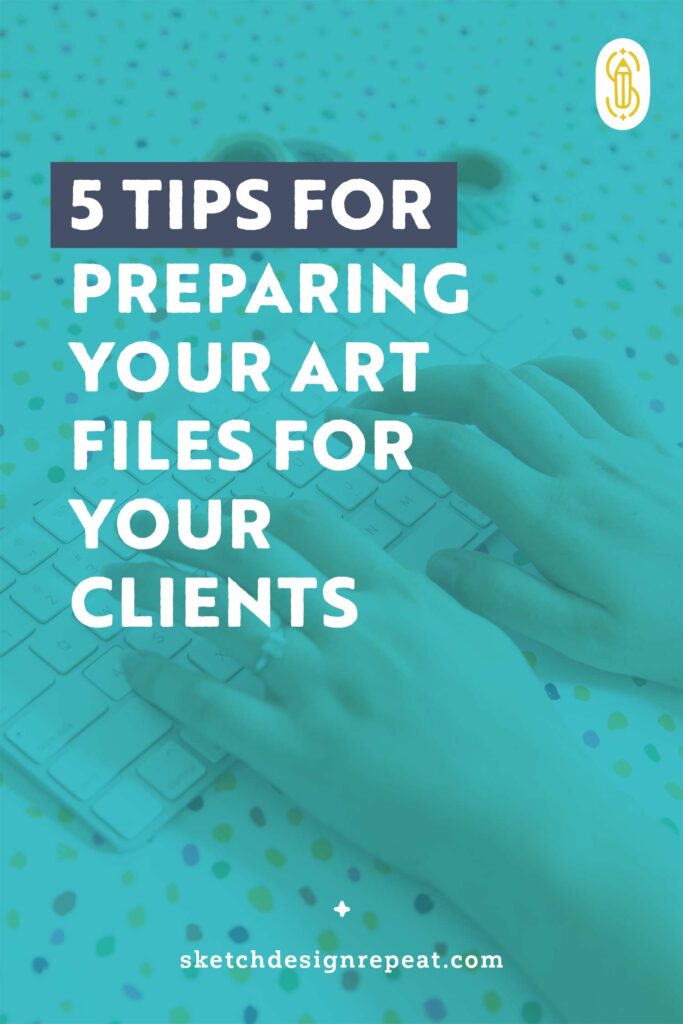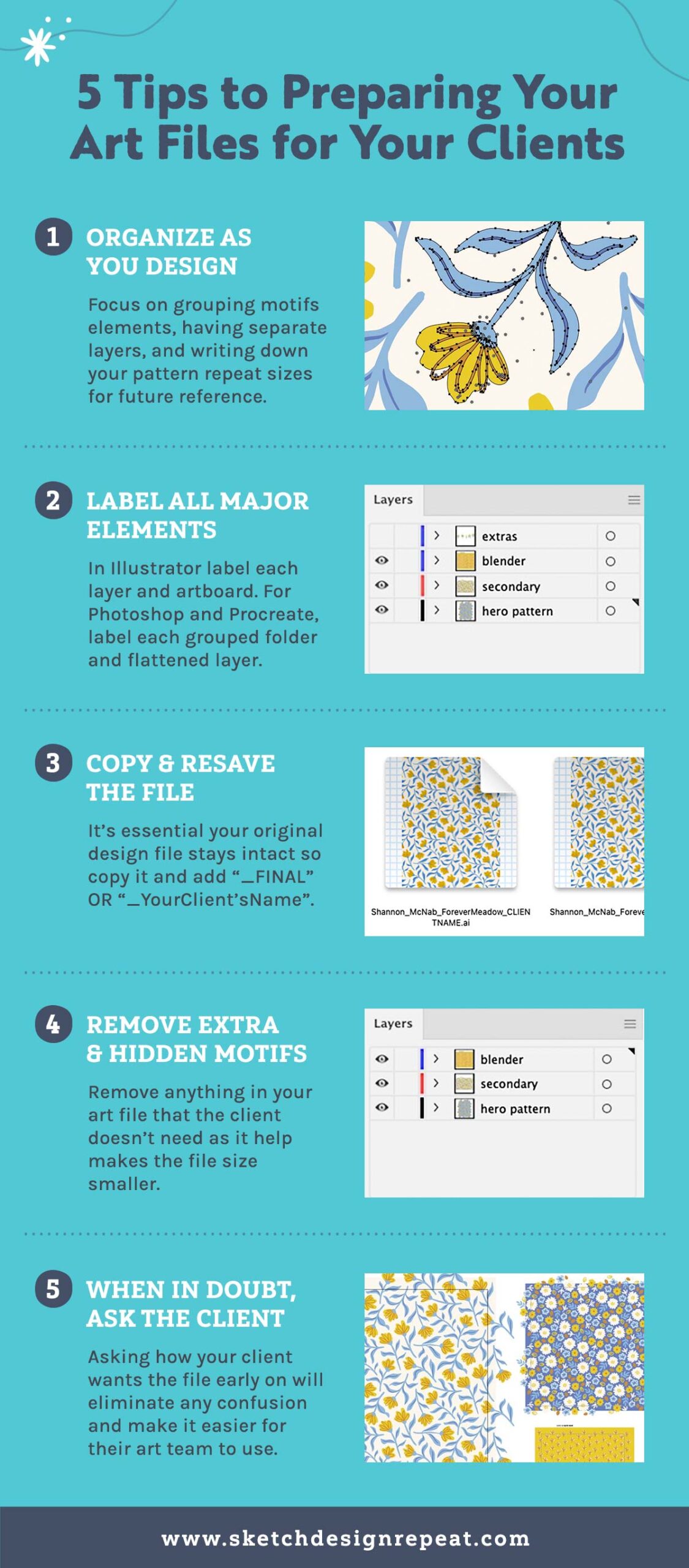I get a asked a lot of the same questions by my surface design students or artists in my inbox and I’ve answered several here already…
- Is it ok to have my portfolio designs on print-on-demand sites like Spoonflower?
- Photoshop or Illustrator, does it matter which one should I use?
- What should I do when I email an art director but don’t hear back?
- What the heck is a half-drop repeat? Or an implied repeat?
But today, I’m answering another popular question, one I get asked more frequently than almost any other:
“How do I prepare my design files for surface design clients?”

As someone who loves talking about organization, I’m excited to finally tackle this one and share my top 5 tips for organizing your files before sending art to your clients.
Now this list is FAR from an exhaustive list of everything you can (and should) do to clean up your files – and P.S. if you want more help, I often demonstrate file clean-up to my Pitch Your Portfolio students in our quarterly live calls – but it’s the advice I most often give when asked this question.
Also, if you’re a visual person, we’ve included a nifty infographic at the end of this post that you can save on Pinterest to reference later.
Ok, let’s dive right in…
1. Organize as You Work
Keeping your design files organized as you’re working on them probably sounds pretty obvious, yet so many surface designers don’t do it. But getting into the habit of building clean design files, no matter what design program you work in, could potentially save you hours of file clean-up later on when a client has you sending art portfolio files – so it’s worth it!
But maybe you’re not sure what or how you should be organizing your files. Well, here are three of my favorite organization workflow tips:
- Each motif should be grouped together. This makes it easier for you and your client to move motifs around.
- If you like to design multiple patterns or illustrations in the same Adobe Illustrator file, each one should be on its own layer and artboard. This allows you or a client to hide other parts of a collection to focus on the one that needs to be adjusted.
- Consider writing down the pattern repeat dimension for reference. This is especially helpful if like me, you don’t design within the same pattern dimensions each time. I usually include a hidden text layer of the width and height on the corresponding layer in Illustrator or within a grouped folder in Photoshop. The benefit is it’s one less thing I have to remember.
2. Label Everything
I could have included this as one of the bullets in the last tip, however, it’s such a crucial step that I thought it deserved to be called out on its own.
Because a well-organized file should have its major elements labeled so the client doesn’t have to guess what or where something is in your file.
You don’t have to go crazy and name absolutely every little grouped motif and individual element in your files, but you should at least label the big stuff. For example, in Adobe Illustrator that means labeling each layer and if you have multiple artboards, it’s best to label those too. For Photoshop and Procreate, you can simply label each grouped folder and flattened layer.
Related Article: Make Your Design Time More Productive
3. Copy & Resave
This is another step a lot of artists don’t take, however, it’s essential to do so that your original design file stays intact with all the extra or hidden bits you may have in it.
So before you do anything else to prep your file, copy it and then add “_FINAL” or “_YourClient’sName” to the end of it so there’s no confusion on which file you’ll be sending off to your client.
And depending on how often you’ll be sending art files, you can go a step further and create individual folders for each client to save the edited artwork.
4. Remove Extras
When I’m designing, I often have a lot of extra motifs and pattern versions that don’t make the final cut when presenting the design in my surface design portfolio. You might decide to delete these elements from the file because they’re unused.
However, I can’t tell you how many times I’ve gone back to a file to find something I know I created in the file or to refresh the design a few years later. That’s why I NEVER delete any extra elements I didn’t use in my files and it’s something I suggest you do as well.
That doesn’t mean you should give all those extras to your client though. So make sure to do a quick pass and remove anything in your art file that the client doesn’t need. It makes the file size smaller but also means you’ll never give the client more than what they paid you for.
5. When in Doubt, ASK
Although the tips above are general guidelines you should follow when preparing your files, it doesn’t mean there aren’t other expectations the client has about how they’ll receive them.
That’s why it’s always best to ask your client before you’ve even signed a contract.
Asking this question early on will eliminate any confusion. It will also ensure you’ll be sending art in a way that works for their design team and make it easier for them to put their products into production. Just make sure to follow through on any directions they give you and make those adjustments to your file.
And if you don’t understand what they want you to do, ask for clarification. I know many artists don’t want to come across as inexperienced or stupid, but there’s no shame in seeking advice. Most art directors are lovely people who genuinely want to help artists, so never be afraid to ask more questions.
There you have it: my top 5 tips for preparing your art files before sending them to a client. If you’d like to reference these tips for later, just add the infographic below to your Pinterest account.
Of course, there’s a LOT more I could say about organizing your art portfolio and design files – my Pitch Your Portfolio students know that all too well – but as long as you take a proactive approach to keep your files organized and ask your client questions when needed, you’ll do just fine!
Want to save this post to find it later? PIN IT!

Thank you!
I so needed this!
Another burning question – what do you do with all your procreate designs and best way to back them up?
I will be trying out your tips today!
Suzanne
So glad you found this helpful Suzanne! As for your Procreate designs, it’s always a good idea to save them as layered PSDs or TIFF files either in cloud storage (like Dropbox) or on a second device or external hard drive – this way in case something happens to your iPad, you’ll still have the art!
This is really helpful, thanks!
Really good advice, I’ve just started cleaning up some of my older Illustrator files as I found I had the same ‘loose’ motif repeated so many times – I’m deleting all extras and just leaving one of each, that way files are reduced in size a little. And just starting to work in layers these days, so many possibilities!
Thank you for this so clear organizing tips. It’s really helpful.
One thing I would like to know – is it good to save my pattern files in swatch library or is it better to save it as a regular illustrator file. This I just mean for organizing purpose and not for sending it to client.
Thank you!